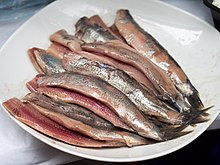 Lightly brined raw herring, also known as Hollandse Nieuwe, Netherlands | |
| Place of origin | Netherlands |
|---|---|
| Main ingredients | Herring, vinegar; any of cider, wine, tea, sugar, herbs (usually bay leaf), spices (usually mace), chopped onion |


Soused herring is raw herring soaked in a mild preserving liquid. It can be raw herring in a mild vinegar pickle or Dutch brined herring. As well as vinegar, the marinade might contain cider, wine or tea, sugar, herbs (usually bay leaf), spices (usually mace), and chopped onion.
The word 'soused' can also describe a marinated herring that has been cooked.[1] The herring is usually baked in the (vinegar) marinade (but can be fried and then soaked in the marinade). It is served cold. This is usual in Scotland, Wales and Ireland.[2]
The soused herring (maatjesharing or just maatjes in Dutch, or Matjes/matjes in German and Swedish respectively) is an especially mild salt herring, which is made from young immature herrings. The herrings are ripened for a couple of days in oak barrels in a salty solution, or brine. The pancreatic enzymes which support the ripening make this version of salt herring especially mild and soft. Raw herring pickled in vinegar are called rollmops.
As of 2015, within the EU, Dutch made Hollandse Nieuwe, Holländischer Matjes and Hollandse maatjesharing have TSG Certification[3] and German produced Glückstädter Matjes, produced in Schleswig-Holstein has PGI certification.[4] As a pickled herring it can form one course of the traditional twelve-dish Christmas Eve supper in Poland.
- ^ "Saffron Orange Soused Mackerel Salad". The British Larder. Retrieved May 22, 2010.
- ^ Davidson, Alan (October 1988). North Atlantic Seafood. Penguin. pp. 440, 463. ISBN 0140468153.
- ^ EU TSG Certification Database Entry (Accessed November 2015)
- ^ EU PGI Certification Database entry (Accessed Nov/2015)